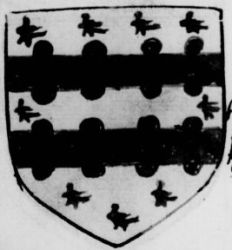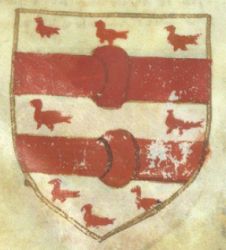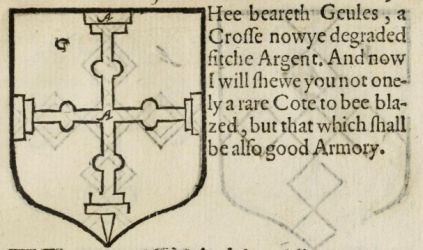Society for Creative Anachronism
College of Arms
For the August 2020 meetings, printed October 12, 2020
To all the College of Arms and all others who may read this missive, from Juliana Laurel, Alys outgoing Pelican, Elizabeth incoming Pelican, and Oddr Wreath, greetings.
Starting November 1, 2020, Lady Lilie Dubh inghean uí Mórdha, previously Pantheon Herald from the East, assumes the office of Ragged Staff Herald. On behalf of the College, I thank Magnifica Seraphina Delphino for her years of diligent service in the position and welcome Lilie to the Laurel staff.
Seraphina has diligently worked with all the kingdoms to make sure that paperwork is in order and keep the heraldic decision meetings orderly and on track. She's been a dream to work with; she's proactive, solves problems, and just makes things happen. Lilie's been working hard to learn ALL THE THINGS (seriously, she's constantly asking questions and taking notes about everything). She's going to do a marvelous job.
The College of Arms has a rank of Herald Extraordinary that has a long and honored history. The rank was formally created and defined in the July 1981 Cover Letter by Wilhelm Laurel. The intent of the rank is to recognize and reward "... those heralds who have greatly served the College of Heralds and/or the College of Arms and have achieved the highest level of competence in heraldry."
Magnifica Seraphina has served honorably and well as Ragged Staff, only the latest among her many heraldic jobs. I hereby confer upon her the rank and style of Herald Extraordinary, and charge her to register a title of her choosing and use it in perpetuity.
As is customary, when we break in a new Sovereign of Arms, we do it gently by splitting the workload. This month, the decisions were split as follows:
For the month of August, Alys wrote the decisions for the Kingdoms of Æthelmearc, An Tir, Ansteorra, Artemisia, Atenveldt, Avacal, Caid, and Calontir, while Elizabeth handled Drachenwald, Ealdormere, East, Lochac, Middle, Northshield, and the West.
In a 2004 precedent, we previously ruled that triple given names could not be registered in Spanish. [Isabella Maria-Magdalena Fernandes de Chaves, 05/04, R-Trimaris] However, new data has uncovered examples of what reasonably can be read as triple given names in late period and gray period Spain. For example, Lilie Pantheon noted Barthomeu Jaume Lambert Miquel Bonavantura Marcha, Maria Anna Elena Casadaval and Angela Orosia Magdalena Planas, all found in a gray period church register from Gerona, Spain. Kolosvari Arpadne Julia provided images of the primary source documents to confirm these examples.
Although this pattern is rare, it is attested and therefore can be registered. Accordingly, we hereby overturn the May 2004 precedent noted above and permit the registration of triple given names in late period and gray period Spanish.
This month we were asked to consider whether we protect single-element names from relationship conflict under SENA PN.3.D. In the early days of the SCA College of Arms, a person's name was less important than their armory and a number of elements registered then can no longer be registered now. This is true also of single-element names, which the College last registered in January 1980. As of this Cover Letter, there are only ten of these names still registered.
The standard for SENA PN.3.D is an "unmistakable close relationship with a protected person". With a single-element name, this is impossible to achieve; there is no way of knowing whether this single element is intended to be a given name or a byname. Therefore, as of this writing, SENA PN.3.D does not apply to single-element names. We ask Palimpsest to draft a Rules Letter to incorporate this clarification to the rule.
Because of the identifiability issues presented and outstanding questions regarding their sources, variant and non-traditional forms of ermine spots are disallowed unless accompanied by documentation of the form to period. The common depiction of an ermine spot as a tail with three dots does not require documentation. Any depiction used must remain at least as identifiable as its source.
Those interested in variant forms may wish to consult Iago Coquille's KWHSS presentation, May the Furs be With You and his accompanying paper, both found in the KWHSS 2020 Proceedings at https://heraldry.sca.org/kwhss/2020/#furs. A wide variety of ermine spots are cataloged from period armorials, as are depictions of vair. Submitters are reminded that materials hosted at https://heraldry.sca.org are non-photocopy resources per Appendix H of the Administrative Handbook.
We were asked this month to reconsider our basis for registering ordinaries nowy. The two basic questions were whether ordinaries nowy were known to period heraldry, and what were the ordinaries found to be nowed.
Based on Iago Coquille's research we are choosing to declare that all ordinaries nowy carry a step from period practice, except for the fess nowy for which we have period evidence, and the "cross nowyed" as depicted in The accedence of armorie (but, notably, not as typically depicted in Society armory). For simplicity, we'll use the term nowy for each.
The below information is an excerpt from Iago's excellent article, "'Nowy' in Period Heraldry", found at https://heraldry.sca.org/armory/nowy/.
Fesses/bars
Nowy appears to be a Breton invention. Research found no bars nor fesses nowy outside of Brittany. The earliest blazon found that describes these as "nowy" ("noues") is provided for the Matignon de Gouyon arms, in Extraict du livre de Navarre, 16th C French (Paris, BnF, ms. Français 32487), f. 33r (https://gallica.bnf.fr/ark:/12148/btv1b9063216f).
Other period blazons found for them so far call them pumelees [1] or arrestees [2], though the one that uses pumelees draws the bars with multiple bumps, so there seems to have been some confusion by the artist. They are typically drawn as something like two demi-roundels issuant from either side of the fess/bar, but the images found for Lestrelin seem to match the typical SCA emblazon of an outline like a roundel surmounting a fess.
Crosses
No known period examples were found of what we consider a cross nowy (according to both Parker, A Glossary of Terms Used in Heraldry, and Bruce Draconarius of Mistholme, The Pictorial Dictionary of Heraldry).
The accedence of armorie, 1597, has one example of a crosse nowye [3], drawn with projections in the middle of each arm, as opposed to the center of the charge where the arms meet. Parker describes this style as nowyed, distinct from nowy.
Other Ordinaries
No examples found.
Sources
Armorial de France et traités de blason, 16th C French (Paris, BnF, ms. NAF 1075), p.157
Le Jouvencel, 1475 French (Paris, BnF, ms. Français 24381), f.170v
Legh, Gerard: The accedence of armorie, 1597 English



This month we reblazoned a few items with torques to match the Society default of opening to base.
The May 2019 Palimpsest Rules Letter proposed changes to SENA A3E2 and Appendix M, in accordance with past rulings. We are approving these changes, with some further clarifications to Appendix M.
SENA A3E2
2. Complexity Count: We require that any submission not exceed a certain "complexity count," measured by adding the number of types of charges to the number of tinctures. Items with a complexity count of eight or less receive no penalty for complexity from this rule. Furs, such as ermine and vair, count as a single tincture rather than their component tinctures. Charges that have different names in different tinctures or orientations (roundels, crescents, gouttes) are considered one type regardless of the term used for them. All charges, including maintained charges, are counted, though objects worn by an animal or person do not add to the charge count. All tinctures are counted except those used only for normally unblazoned artistic details such as teeth, claws, or eyes. Proper is not a tincture, but a description of a group of tinctures. Each tincture of a proper charge is counted separately, except for artistic details.
For example, Vert, in fess two straight trumpets palewise Or and a chief argent has a complexity count of five, while Vert, in fess two straight trumpets palewise and a chief Or has a complexity count of four. Vair, a squirrel gules has a complexity count of three. Argent, a brown monkey proper vested gules has a complexity count of four: there is one charge (the vest, as a worn object, doesn't count as a charge) but three tinctures (including the tincture of the vest). For example, a ford proper has two tinctures, azure and argent. Thus, Or, a squirrel gules and a ford proper has a complexity count of six. For example, a rose proper is a gules charge; the tinctures of the barbs and seeds are artistic details. Thus, Per fess sable and azure, on a fess argent, three roses proper has a complexity count of six.
An item with a complexity count of nine or higher that follows a period pattern of charges and tinctures may be registered, but may need to be documented as an Individually Attested Pattern.
Insert/Delete Version
2. Complexity Count: We require that any submission not exceed a certain "complexity count," measured by adding the number of types of charges to the number of tinctures. Items with a complexity count of eight or less receive no penalty for complexity from this rule. Furs, such as ermine and vair, count as a single tincture rather than their component tinctures. Charges that have different names in different tinctures or orientations (roundels, crescents, gouttes) are considered one type regardless of the term used for them. All charges, including maintained charges, are counted, though objects worn by an animal or person do not. like and tinctures, each of which separately.
For example, Vert, in fess two straight trumpets palewise Or and a chief argent has a complexity count of five, while Vert, in fess two straight trumpets palewise and a chief Or has a complexity count of four. Vair, a squirrel gules has a complexity count of three. Argent, a brown monkey proper vested gules has a complexity count of four, , because the tincture of the vest is also countedhas three tinctures, each of which is counted for complexity, so eight.
An item with a complexity count of nine or higher that follows a period pattern of charges and tinctures may be registered, but may need to be documented as an Individually Attested Pattern.
Appendix M
Broadly, complex lines of division fall into several groups. In general, there is a DC between variants that belong to different groups. In addition, there is in general a DC between any two lines in the "other" group, as it is a catch-all with no relationship between them. Those lines of division listed as "straight line and variants" also conflict with a straight line.
Straight line and variants: plain, ployé enarched, arrondi (for divisions greater than four)
Square: embattled, dovetailed, bretessed, embattled counterembattled, raguly, denticulada
Wavy: Wavy, nebuly, urdy
Long: Rayonny
Jagged: indented, engrailed, invected, dancetty, lozengy
Other: bevilled, potenty, flory-counterflory, indented fleury at the points, left step/right step, rompu, triangular
For a two-sided ordinary, such as a fess or a pale, there is a DC between "dancetty" and other line styles in the "jagged" group.
Insert/Delete Version
Broadly, complex lines of division fall into several groups. In general, there is a DC between variants that belong to different groups. There is in general a DC between any two lines in the "jagged" group; as research has proved that these lines were common and were considered distinct by period heralds unlike the situation for the "square" group and the "wavy" group."variants of straight line"
Straight line and variants: plain, ployé enarched, arrondi (for divisions greater than four)
Square: embattled, dovetailed, bretessed, embattled counterembattled, raguly, denticulada
Wavy: Wavy, nebuly, urdy
Long: Rayonny
Jagged: indented, engrailed, invected, dancetty, lozengy
Other: bevilled, potenty, flory-counterflory, indented fleury at the points, left step/right step, rompu, triangular
For a two-sided ordinary, such as a fess or a pale, there is a DC between "dancetty" and other line styles in the "jagged" group.
Please send information about happenings to major heralds and major happenings to all heralds to Laurel, so that it can be published here.
Letters of Intent, Comment, Response, Correction, et cetera are to be posted to the OSCAR online system. No paper copies need be sent. All submission forms plus documentation, including petitions, must be posted to the OSCAR online system. While black-and-white emblazons must be included in the Letter of Intent, only colored armory forms need to be posted in the forms area.
Cheques or money orders for submissions, payable to "SCA Inc.-College of Arms" are to be sent to Trent Le Clair, 928 Frazier Dr, Walla Walla WA 99362
Send roster changes and corrections to Laurel. College of Arms members may also request a copy of the current roster from Laurel.
For a paper copy of a LoAR, please contact Laurel, at the address above. The cost for one LoAR is $3. Please make all checks or money orders payable to "SCA Inc.-College of Arms". The electronic copy of the LoAR is available free of charge. To subscribe to the mailings of the electronic copy, please see the bottom of http://heraldry.sca.org/heraldry/lists.html#lists for more instructions.
For all administrative matters, please contact Laurel.
Items listed below in square brackets have not been scheduled yet. For information about future scheduling, please review the status table located on the Web at http://oscar.sca.org/index.php?action=137.
The August Laurel decisions were made at the Pelican meeting held on Sunday, August 9, 2020 and the Wreath meeting held on Saturday, August 8, 2020. These meetings considered the following letters of intent: Middle (02 May, 2020), Calontir (05 May, 2020), An Tir (10 May, 2020), Laurel (18 May, 2020), Laurel LoPaD (19 May, 2020), Palimpsest Rules Letter (19 May, 2020), Ealdormere (24 May, 2020), Atenveldt (25 May, 2020), Northshield (26 May, 2020), Artemisia (29 May, 2020), Caid (29 May, 2020), Ansteorra (30 May, 2020), West (30 May, 2020), Æthelmearc (31 May, 2020), Avacal (31 May, 2020), Drachenwald (31 May, 2020), East (31 May, 2020), and Lochac (31 May, 2020). All commentary, responses, and rebuttals should have been entered into OSCAR by Friday, July 31, 2020.
The September Laurel decisions were made at the Pelican meeting held on Sunday, September 13, 2020 and the Wreath meeting held on Saturday, September 12, 2020. These meetings considered the following letters of intent: Meridies (01 Jun, 2020), Middle (06 Jun, 2020), Calontir (08 Jun, 2020), An Tir (09 Jun, 2020), Gleann Abhann (11 Jun, 2020), Palimpsest Rules Letter (12 Jun, 2020), Laurel LoPaD (20 Jun, 2020), Atlantia (21 Jun, 2020), Middle (21 Jun, 2020), Ealdormere (24 Jun, 2020), Ansteorra (28 Jun, 2020), Outlands (28 Jun, 2020), Atenveldt (29 Jun, 2020), Laurel LoPaD (29 Jun, 2020), Northshield (29 Jun, 2020), Æthelmearc (30 Jun, 2020), Avacal (30 Jun, 2020), Caid (30 Jun, 2020), Drachenwald (30 Jun, 2020), East (30 Jun, 2020), and Laurel LoPaD (31 Jul, 2020) (redraws). All commentary, responses, and rebuttals should have been entered into OSCAR by Monday, August 31, 2020.
The October Laurel decisions were made at the Pelican meeting held on Sunday, October 11, 2020 and the Wreath meeting held on Saturday, October 3, 2020. These meetings considered the following letters of intent: Lochac (04 Jul, 2020), Calontir (06 Jul, 2020), An Tir (11 Jul, 2020), Gleann Abhann (12 Jul, 2020), Artemisia (16 Jul, 2020), Gleann Abhann (21 Jul, 2020), Ealdormere (24 Jul, 2020), Atenveldt (25 Jul, 2020), Æthelmearc (26 Jul, 2020), Atlantia (28 Jul, 2020), Palimpsest Rules Letter (28 Jul, 2020), Ansteorra (29 Jul, 2020), Caid (29 Jul, 2020), Laurel LoPaD (29 Jul, 2020), Outlands (29 Jul, 2020), An Tir (30 Jul, 2020), Avacal (30 Jul, 2020), West (30 Jul, 2020), Drachenwald (31 Jul, 2020), East (31 Jul, 2020), Northshield (31 Jul, 2020), and Laurel LoPaD (31 Aug, 2020) (redraws). All commentary, responses, and rebuttals should have been entered into OSCAR by Wednesday, September 30, 2020.
Not all letters of intent may be considered when they are originally scheduled on this cover letter. The date of posting of the LoI, date of receipt of the Laurel packet, or other factors may delay consideration of certain letters of intent. Additionally, some letters of intent received may not have been scheduled because the administrative requirements (receipt of the forms packet, receipt of the necessary fees, et cetera) have not yet been met.
REMINDER: Until all administrative requirements are met, the letter may not be scheduled.
Pray know that I remain,
In service,
Juliana de Luna
Laurel Queen of Arms
Created at 2020-10-12T18:09:58